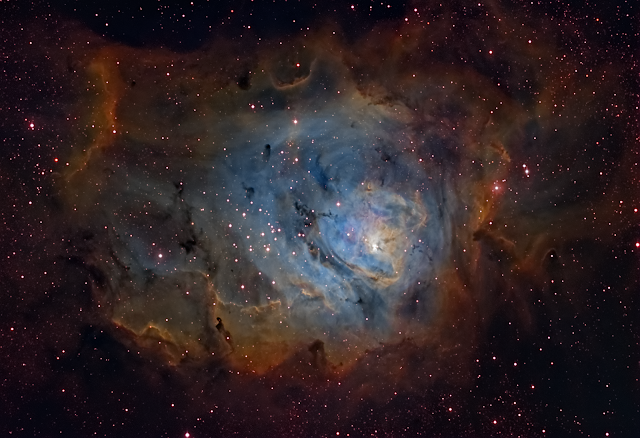The Lagoon Nebula (catalogued as Messier 8 or M8, and as NGC 6523) is a giant interstellar cloud in the constellation Sagittarius. It is classified as an emission nebula and as an H II region.
The Lagoon Nebula was discovered by Guillaume Le Gentil in 1747 and is one of only two star-forming nebulae faintly visible to the naked eye from mid-northern latitudes. Seen with binoculars, it appears as a distinct oval cloudlike patch with a definite core. A fragile star cluster appears superimposed on it.
The Lagoon Nebula is estimated to be between 4,000-6,000 light years from the Earth. In the sky of Earth, it spans 90' by 40', translates to an actual dimension of 110 by 50 light years.
Like many nebulas, it appears pink in time-exposure color photos but is gray to the eye peering through binoculars or a telescope, human vision having poor color sensitivity at low light levels. The nebula contains a number of Bok globules (dark, collapsing clouds of protostellar material), the most prominent of which have been catalogued by E. E. Barnard as B88, B89 and B296. It also includes a funnel-like or tornado-like structure caused by a hot O-type star that emanates ultraviolet light, heating and ionizing gases on the surface of the nebula.
The Lagoon Nebula also contains at its centre a structure known as the Hourglass Nebula (so named by John Herschel), which should not be confused with the better known Hourglass Nebula in the constellation of Musca. In 2006 the first four Herbig-Haro objects were detected within the Hourglass, also including HH 870. This provides the first direct evidence of active star formation by accretion within it.
http://en.wikipedia.org
Instruments and exposure data:
W.O FLT110 with dedicated TMB field flattener
FeatherTouch 3'' focuser
Starizona MicroTouch autofocuser
W.O ZS80 ED
SBIG ST10XME CFW9
Meade DSI
Filters:
Ha 5nm Astrodon
SII 8nm Baader
OIII 3nm Astrodon
Sky-Watcher EQ6 Pro
Ha :35*6min bin1x1 (3.5hours)
OIII :20*8min bin 1x1(2.66hours)
SII :23*10min_8*8min (4.9hours)
Total exposure 11 hours
Vironas Athens Greece
http://en.wikipedia.org
Instruments and exposure data:
W.O FLT110 with dedicated TMB field flattener
FeatherTouch 3'' focuser
Starizona MicroTouch autofocuser
W.O ZS80 ED
SBIG ST10XME CFW9
Meade DSI
Filters:
Ha 5nm Astrodon
SII 8nm Baader
OIII 3nm Astrodon
Sky-Watcher EQ6 Pro
Ha :35*6min bin1x1 (3.5hours)
OIII :20*8min bin 1x1(2.66hours)
SII :23*10min_8*8min (4.9hours)
Total exposure 11 hours
Vironas Athens Greece




